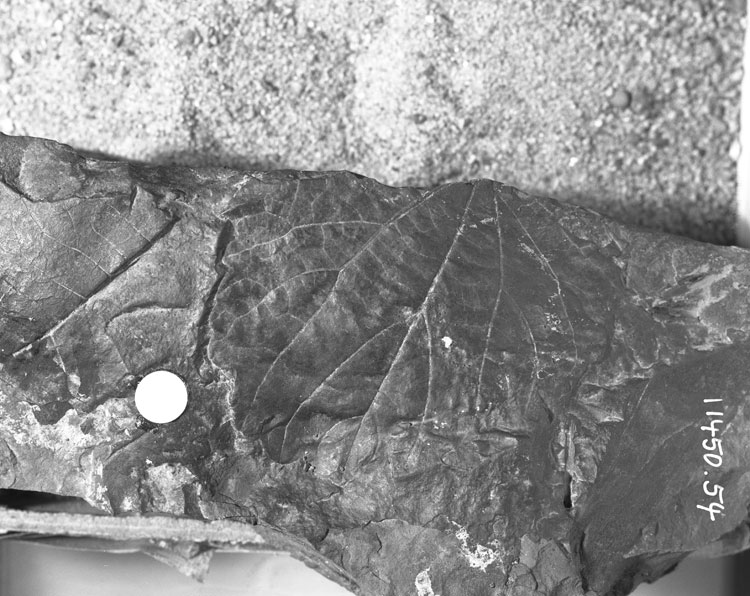Locality
Arctic Slope of Alaska locality USGS 11606, north of Maybe Creek. This locality is a bluff approximately 10 m high on the east side of an unnamed tributary of the Price River. The predominant lithologies are bentonitic clays overlying a silty sandstone capped by coal beds up to 2 m thick, which are in turn overlain by a white-gray medium-grained sandstone. Irregularly dispersed throughout the clay are nodules and sheets of ferruginous limestone (sideritic) which, although light gray when fresh, weather to a rusty brown. With the exception of some poorly preserved plant matter in the upper sandstones, and impressions of platanoid leaves in the power sandtsones, the plant material is confined to these fine-grained iron-rich nodules and is preserved as impressions totally lacking cuticle. There is little evidence of post-mortem decay but many leaves are penetrated by vertical fossil rootlets. Platanoid leaves are most common in siltier/sandier facies. The uppermost coal surface supports several in situ tree bases each of which is approximately 20 cm in diameter.
Latitude: 69.528329 °N
Longitude: -153.887128 °W
Description
Leaf: simple; symmetrical; orbiculate (?); apex missing but probably rounded; base missing; margin crenate, teeth large (up to 5.0 mm long) almost semicircular with sharply rounded sinuses, the medial vein of the tooth extending slightly beyond the apex forming a short glandular (?) projection; venation marginal actinodromous; primary midvein moderate more or less straight, pectinal veins arising at an angle of 30° from the midvein inwardly curving towards the apex and branched approximately halfway along their length into two veins of equal thickness, the abmedial vein of this pair branching more frequently than the admedial; superior secondary veins moderate arising at an angle of 35-40° from the midvein and uniformly curved in an apical direction before terminating in teeth apices; pectinal abmedials tending to terminate as the medial veins of teeth but branching admedially to join superadjacent pectinal abmedials, or branches thereof, at an acute angle; tertiary veins percurrent, often simple, straight or convex, but commonly branched, joining parent veins at varying angles but commonly at right angles; fourth order veins percurrent to reticulate, branched, sometimes orthogonal to tertiaries.
Remarks
The pectinal veins are considered to dichotomize halfway along their length because the two branches are of equal thickness and the course of the pectinal vein alters to accomodate the dichotomy. The looping of the pectinal abmedials is not well developed and in some places seems to be formed by a tertiary vein running between the abmedials or their branches. The venation as a whole is by no means well organized but further detailed analysis, particularly of the marginal venation, is precluded by poor preservation. The venation details that are present, however, suggest affiliation with the Trochodendroides/'Cercidiphyllum' complex in that the leaf possesses a crenate margin, inwardly curving actinodromous venation, and camptodromous secondary veins.
Leaves with an almost identical venation have been described in Takhtajan (1974; Text Fig. 74) as Trochodendroides speciosa (Ward) Berry. The plate figures do not display the dichotomy of pectinals as is present in specimen USGS 11606.54 but Takhtajan's Text Fig. 74 leaf 4 shows a weak tendency for this condition. Takhtajan gives a stratigraphic range of Maestrichtian to Paleocene, but clearly this has to be extended to the Coniacian because specimen UIDAHO 3/15, 19, 26.1 (Dicot 91) of Smiley is identical to specimen USGS 11606.54 in all aspects of venation except the dichotomizing pectinals. The teeth of specimen UIDAHO 3/18, 19, 26.1 also appear to be smaller in relation to the leaf size than those of specimen USGS 11606.54.
Leaves of this type have been assigned to a number of species (Trochodendroides speciosa, T. vassilenkoi Iljinskaja and Romanova, 'Cercidiphyllum' richardsonii (Heer) Seward and Edwards, and 'Cercidiphyllum' crenatum (Unger) Brown, for example) and have a range from Turonian to late Paleogene. They appear to be most widespread, however, around the Cretaceous-Tertiary boundary.
